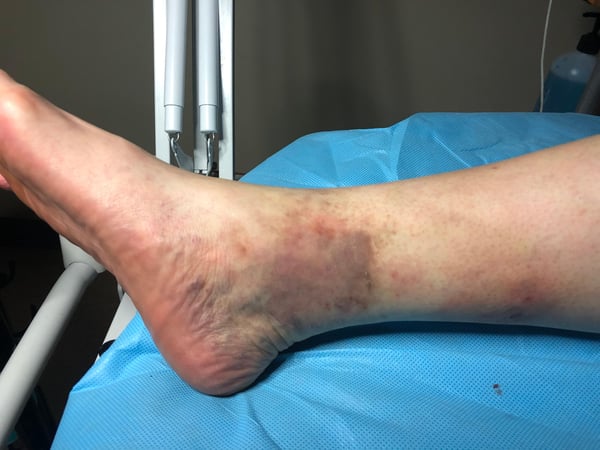What is Chronic Venous Insufficiency?

Chronic venous insufficiency is a vascular and health condition that epidemiologists estimate affects between 25-40% of women and 10-20% of men in the United States. That adds up to between 115 million to 198 million in the US. Chances are high that you know someone who has chronic venous insufficiency, or maybe you even have it yourself without knowing it. But chances are also high that you may not know exactly what chronic venous insufficiency is, how to recognize it and – most importantly - what can be done to treat it. This article will give you everything you need to know to better understand the condition and get the treatment you need.
Chronic venous insufficiency prevents the return of blood to your heart and slows circulation.
There are three parts to the definition of chronic venous insufficiency. This condition is:
- Chronic, in the sense that it develops over a period of years and persists for years if it is not treated.
- Venous, because it involves the veins – those blood vessels that return blood to the heart from the legs. (As opposed to arteries which carry blood away from the heart to the legs.)
- Abnormal vein circulation, also called insufficiency, and the vein circulation slows down which causes the symptoms and health consequences of the condition.
Chronic venous sufficiency is a condition in which the veins in the legs lose their ability to carry blood back to the heart efficiently, circulation slows down and health is compromised.
Blocked flow at different levels causes different symptoms.
Most commonly, the problem is with veins near the surface of the skin - this is called superficial venous insufficiency. These veins are the great saphenous vein in the thigh and calf and the small saphenous vein in the calf, and when they do not work it causes a condition known as vein reflux. It’s a common cause of leg symptoms and generalized fatigue.
Less commonly, the problem is with veins that lie deep in the legs, the so called deep veins including the anterior tibial, posterior tibial, popliteal, deep femoral, femoral, peroneal, common femoral and iliac veins. These veins are subject to a condition called DVT, or deep vein thrombosis. It’s a condition that occurs most commonly with inactivity such as after surgery, after injury, and during long airline flights when passengers can’t get up from their seats and walk around.
Venous reflux causes symptoms that always get worse over time. DVT can be a real medical emergency with symptoms such as leg pain and swelling that manifest themselves very quickly. Let’s take a look at the different kinds of symptoms that can tell you how soon you need to visit your healthcare provider.
Subtle and not-so-subtle symptoms.
 There are very common signs that blood isn’t flowing back to your heart the way it should. You could notice blotches of brown or red skin on your legs around your ankles, and in advanced cases, the skin becomes hard and tough due to scar tissue. People often notice that the hair on their calves disappears and the skin on your legs may get dry and flaky. Common symptoms include foot or leg pain or aching, leg swelling, burning, tingling or numb sensations, night cramps, and restless legs. The most common symptom is a feeling of exhaustion and fatigue at the end of the day due to the slow circulation. The good news: these symptoms all improve with vein treatments.
There are very common signs that blood isn’t flowing back to your heart the way it should. You could notice blotches of brown or red skin on your legs around your ankles, and in advanced cases, the skin becomes hard and tough due to scar tissue. People often notice that the hair on their calves disappears and the skin on your legs may get dry and flaky. Common symptoms include foot or leg pain or aching, leg swelling, burning, tingling or numb sensations, night cramps, and restless legs. The most common symptom is a feeling of exhaustion and fatigue at the end of the day due to the slow circulation. The good news: these symptoms all improve with vein treatments.
Another manifestation of chronic venous insufficiency is varicose veins. These are twisting, ropey bulging veins which can be more than just a cosmetic problem. Occasionally a vein condition will result in an a skin sore, also called an ulcer, which usually develops around the inner ankle. It is always preceded by red or brown skin discoloration. The big problem with these skin ulcers is that they won’t go away on their own. You will need treatment for your skin to heal. Imagine living a life with a skin sore that does not heal and you have to put a dressing on it each day. Your life will be a lot simpler if you don’t let chronic venous insufficiency advance that far - preventative medicine is key here!
Treatment for chronic venous insufficiency.
Chronic venous insufficiency is treatable, but you will need a venous ultrasound to confirm the presence or absence of normal arterial and venous blood flow. This has to be a special type of venous ultrasound measuring vein reflux, and not all facilities can perform this. Ask your healthcare provider to set you up for a venous reflux ultrasound exam or contact a vein specialist. If you have symptoms of a vein condition, most often you are advised to increase your walking and leg elevation and use medical grade compression socks to improve blood flow and minimize symptoms. If these do not help, there are office treatments performed in a vein clinic that can make a huge difference in how much chronic venous insufficiency affects your daily life.
The first step toward overcoming chronic venous insufficiency is making the diagnosis. If you work with your healthcare provider, make sure you ask for a reflux venous ultrasound. Simpler is to contact our staff at Missouri Vein Care to set up a free vein screening which can reveal whether or not chronic venous insufficiency is present. If you have a vein condition and undergo treatments, patients notice improvement quickly and return to more normal activities right away.



